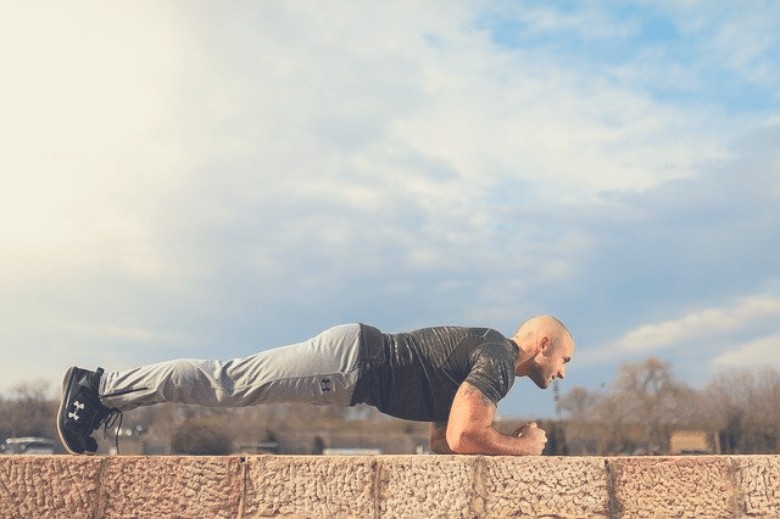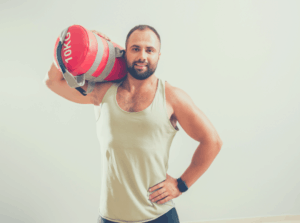No one disputes the importance of training your core strength, but should you train your abs?
Some people might argue that training the anterior core isn’t necessary.
After all, other heavy compound movements like the deadlift and the squat already tackle this, right?
Anterior Core Training
I’d argue it’s crucial to target the anterior core with your workouts.
When you work with a trainer at a gym, it’s not at all uncommon to dedicate two full movements to lateral or anterior core strength and stability training, plus deadlifts and squats. Honestly, it’s a fundamental part of a healthy workout.
Types of Anterior Core Movements
These are the primary movements we like to go through in our routines:
Anterior core dynamic: These exercises generate flow in flexion and throughout the core. These include leg raises, weighted crunches, and leg lowers.
Yes, we incorporate crunches into our routines. After all, the spine is meant to flex; we should improve the ways it’s designed to move.
Anterior core static: These movements resist motion, like planks, farmers walks, body saws, and weighted planks.
Rotational core dynamic: These exercises rotate or twist the spine, meant to stabilize. Our favorites include windshield wipers, Palloff twists, and Russian twists.
Rotational core static: These are movements that stop your spine from rotating. A Palloff press is an iconic example of this type of exercise; here, you alternate between a long lever and a short lever. The goal is to resist movement.
Whenever we train, we make sure to do at least one of these types of exercises. More often, we hit at least two of the categories in a single session. All four core modalities receive equal attention in a given 5-week training block.
Depending on your body needs, you might focus on one type of exercise more than the others.
Facts About Abs

Lots of frustration surrounding getting abs has to do with unrealistic expectations borne from misinformation.
Even though trainers everywhere do their best to inform everyone, people remain committed to outdated ideas about “six-packs” and the best way to work their abs.
Having a strong core really helps with nearly any physical activity, but your abs are just one part of the equation. Your obliques and back muscles also make up your core.
Understanding the myths about abs can help you establish realistic goals that you can reasonably expect to achieve.
Myth 1: Ab Exercises Burns Abdominal Fat
There is a common fallacy that assumes targeting the fat physically with an exercise will make the fat in that area go away. Unfortunately, there is no way to target stomach fat specifically; spot reduction doesn’t work anywhere on the body.
Though exercising your core can improve its strength and endurance, it won’t specifically target the fat in that area. This is because your body doesn’t just gather energy from the targeted area; it draws it from everywhere.
The only way to burn belly fat is to eat fewer calories than you burn in a day.
The best way to do that? Start with a healthy diet and incorporate weight training and cardio into your routines.
This is not a guarantee that you’ll burn belly fat. Genetics play a surprisingly significant factor here. In fact, Harvard researchers state over 400 genes could play some role in obesity.
Myth 2: Ab Muscles are Unique
Too often, people work their abs out regularly without giving them a rest day, believing this will burn fat more quickly.
But, like with any other muscle,your abs need a break to prevent overtraining.
That means working out no more than three times per week, allowing for at least one day of rest between core exercises.
Likewise, be sure to perform a variety of exercises to target the other core muscles. Your abs aren’t just there to look great; they also support your posture and spine.
Myth 3: Ab Muscles Require Lots of Reps
Back in the day, when all we had were fitness videos and group classes, most of us probably did hundreds of crunches. After all, if you want to develop a muscle, you need to keep at it, right?
Wrong. Like I said above, your abs are just like any other muscle. If you wouldn’t do 100 deadlifts, you shouldn’t do 100 crunches.
Endurance matters, but the key to strong abs is quality, not quantity.
Making core strength gains requires applying the same principles as the rest of your body: You need to overload your muscles.
The only reason we want or can do so many reps is that we’re not working the muscles as hard as possible. This could mean the exercises are too easy, but more often, it’s because our form is poor.
In other words, if you need to do 50 crunches every session before you’re tired, examine your technique and slow it down.
Core Strength Mistakes to Avoid
If you’re anything like me, you saw a great pair of abs and lamented that yours weren’t visible.
Whomever those abs belonged to, they are muscles borne not just out of healthy eating; that torso was carved into shape with hardcore training and later revealed with a smart diet.
The problem with ab training isn’t just that people often make poor eating choices. In fact, what you do is only one part of the core strength equation.
The other half is what you don’t do. That doesn’t mean what kind of foods you avoid. It means avoiding the seemingly insurmountable wealth of misinformation hiding in casual conversation and online.
Top Ten Ab Training Mistakes

If you go to the gym long enough, you’ll see someone making at least one of these mistakes with their training. Learn now, and don’t be That Guy.
Eliminate these errors, and you might notice your abs much sooner than you thought you would.
Mistake 1: Ignoring Compound Exercises
If you only target the ab muscles, in particular, you make the worst mistake possible. Squats, deadlifts, overhead presses, and other compound movements target the entire core. They’re vital to any good strength training program.
Mistake 2: Starting a Routine with Ab Exercises
The core stabilizes the body, and your abs are part of this area.
If you tire your abs at the start of your workout, you’ll struggle to finish other exercises that hit the same muscles, like squats. To be clear, your core protects your spine, so you want it to operate at full power until the end.
Mistake 3: Believing You Can Out-Exercise Your Pizza Habit
The only way anyone will see your abs is if you lower your body fat percentage. There’s just no right way to do this on exercise alone.
No amount of crunches will help you see that six-pack if your diet habit doesn’t change.
Mistake 4: Creating a Full Workout for Abs
You only need to spend 15 minutes working on your abs. If you already incorporate deadlifts and squats into your routine, it’s enough to throw in one or two exercises at the end of your routine.
If you don’t already do these compound exercises, start there, and then throw in the ab exercise at the end.
Mistake 5: Targeting the Abs Every Day
We’ve mentioned this already, but it bears repeating.
Abs are just like any other muscle. They need time off to recover. If they don’t get a rest, you’ll overtrain them and potentially injure yourself.
In our opinion, after a hard workout day, it’s a good idea to give your core a couple of days off before targeting it again.
If you wake up the next day ready to do more crunches, you aren’t doing them correctly. Examine your form or upgrade to a more complicated movement and see how you feel tomorrow.
Mistake 6: Relying on Crunches Alone
As useful as crunches are for developing ab muscles, dozens of more useful exercises also target the core.
In fact, I’d argue that a crunch is one of the least efficient movements. Look at planks, pushups, and squats.
Mistake 7: Ignoring Your Form
Don’t writhe to work your ab muscles. You need to be just as much of a stickler for form when developing your core as you are when doing squats.
As you start performing more advanced movements, you’ll quickly find how important form is. There’s no way to progress with these movements if you’re doing them lazily.
Keep focusing on your form, and be sure to engage your abs for each rep.
Mistake 8: Not Exercising Your Lower Back
The abs are just the front part of your core, so it’s common for people to neglect their lower back. Don’t forget about these if you want to protect your spine.
Train your lower back as passionately as you would your ab muscles. Train smart, and you’ll actually be as strong as you’ll feel.
Mistake 9: Not Changing Your Angles
The erector spinae, rectus abdominis, obliques, and transversus abdominis all serve important roles in your core.
As different muscles running in different directions, you must work in multiple angles to properly target them all. Specific advanced movements can easily target all the muscles at once, but crunches serve a beginner just fine.
Mistake 10: Buying Informercial Exercise Equipment
Seriously? There’s no need to waste your money on these things. You might have more progress if you did nothing at all.
Ab Exercises for Core Strength
Surely, we’ve all been there: After a hard workout, it feels like someone literally stabbed us in the back at some point.
Or maybe you tried to jump over a cone only to realize your legs won’t go as high as you thought they would.
Maybe you tried to dodge something only to realize you’re not as fast as you expected you’d be.
A weak anterior core could be a factor in these and other situations.
Benefits of Core Stability Exercises
Core exercises are not unlike going to the dentist. You know they’re essential, and they’re good for you, but you don’t love it.
Because nobody really enjoys core workouts, it’s crucial to think about something I like to think of as the minimum possible workout. We want to focus on drills that give you the most training with as few sets as possible.
Crunches and other exercises that bend your body at the waist don’t target the abs as you’d expect.
The right core strength exercises help with:
- Correct breathing: It may surprise you to learn how much effort you need to expel air. Do you breathe shallowly? You may have a weak core.
- Even force distribution throughout the body: The core protects your spine and keeps it from taking too much impact as you move. If your lower back hurts, you might have a weak core.
- Torso rotation: The core gives your body stability to rotate your oblique muscles. If you’ve ever strained this muscle, you could have a weak core to target.
- Reduces risk of lower bodily injury: Stronger cores react to stimuli more quickly. If you have issues with your knees — you guessed it: It could be a weak core.
- Reduces risk of upper bodily injury: The same theory applies here. A bad shoulder could be a symptom of a weak core.
Your core strength is the keystone of your body’s movement — especially in terms of dynamic exercises. If you suffer from painful, chronic issues, it never hurts to give your core a workout.
Core Strength and Stability Exercises
Here are some examples of drills that improve your core stability and strength:
- Reverse Crunch to Dead Bug: Adding the dead bug exercise increases the challenge to stability, especially since it’s a great movement all on its own. The reverse crunch is a classic core drill.
- One-leg TRX Fallout: Fallouts target the core already, but switching to a single-leg stance increases the challenge.
- Tall, Kneeling Cable Press into an Overhead Lift: Adding the overhead reach to asymmetrical presses increases lateral core stability and your rotary stability. It also throws the anterior core into the mix, so don’t skip this combo movement.
- Plank: Make sure you’re holding your form properly; you shouldn’t be able to hold a plank for very long if you’re a beginner. Common errors include drawing your shoulders together or keeping your hips out of alignment.
- Stability Ball Rollouts: These are a more advanced form of planks. It’s easy to accidentally arch your lower back more than you could on the floor, but don’t do that.
Conclusion
A rock-hard six-pack might be the hallmark of male aesthetics, but developing your core strength is an essential variable in creating a robust and stable body.
Only then will you have the ability to perform at the level necessary to stay healthy and look incredible.



